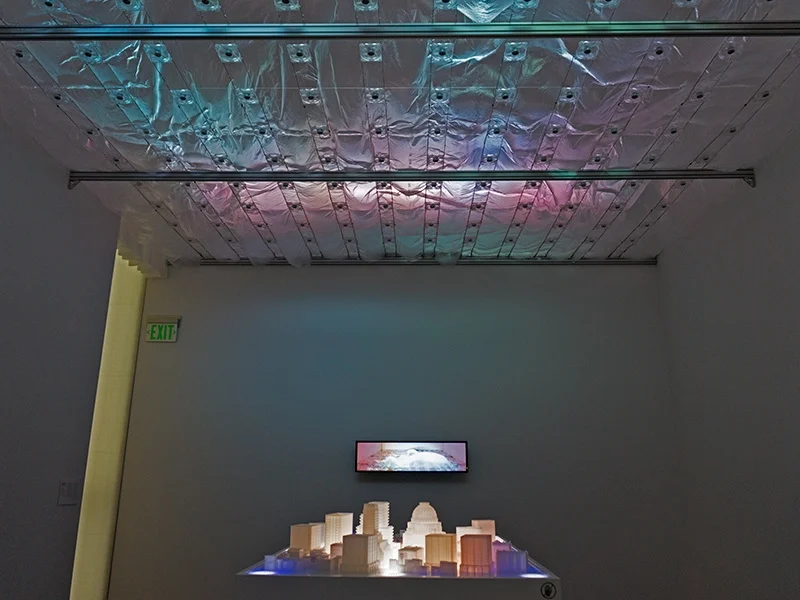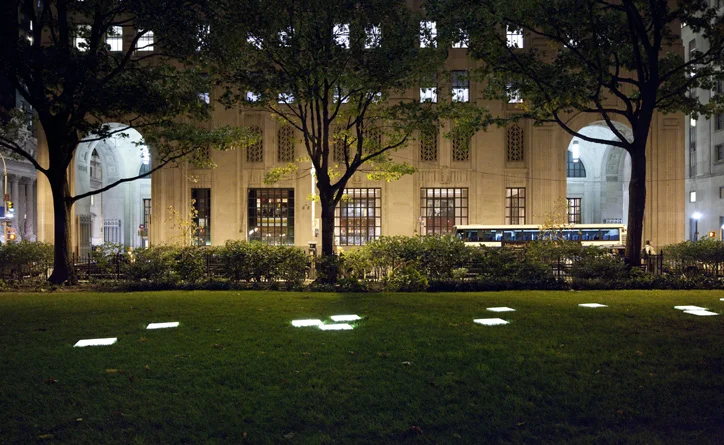Connecting Light
Zach Lieberman in collaboration with Molmol Kuo and Marcela Godoy created Connecting Light along the Hadrian's Wall World Heritage Site in Britain. The work was a part of the 2012 London Cultural Olympiad, an arts and culture festival that was held alongside that year's Olympic Games. Artists from across the globe were invited to create new artworks for the event. YesYesNo, Lieberman's collective with Kuo and Godoy, created around 400 six-foot wide weather balloons that were stationed along the perimeter of the wall. Each balloon was rigged with LED lights, which were powered by radio transmitters. Audiences could then light up the LEDs in the installation by sending text messages via the Connecting Light mobile app or website. The messages would be transmitted between each balloon through the radio devices and be represented as sequences of pulsating color and light. The messages travelled down the chain to each balloon reaching the entire 72-mile long wall.
Hadrian's Wall is a monument from the Roman Empire's border in Great Britain and Lieberman's installation there remains one of the largest outdoor installations in history. Liz Presson of Digi explains how Lieberman formulated this expansive project:
"Zach was approached by the London organizational committee for the Olympic games. He was tasked to respond to Hadrian’s wall with a project that would engage people who are both physically there and who are watching remotely. When Zach went to London to visit the wall, he realized a very symbolic connection between the wall and the Olympics– the wall representing what was once a border and the Olympics being an extension of borders. He responded by creating a communications infrastructure that would allow people, anywhere to send messages along the wall." Presson, Liz (2012, Aug. 9) Internet of Things Expert: Zachary Lieberman
The work creates a platform for interpersonal communication in and around a space that historically represents a divide in community and connections. The work is in opposition of the concept of borders and is meant to bring this expansive landscape into a new context of camaraderie. Linda Tutiett, a representative from Hadrian's Wall World Heritage Site spoke to BBC in preparation of the work's debut:
"We want people to think about Hadrian's Wall in a fresh new light, we want to build an audience for the wall who will care about it for the future. This is one way of getting people to think about some of the world's most amazing heritage, but to do so in such a brilliantly modern way is really going to put the spotlights on Hadrian's Wall Country from all over the world." (2012, Sept. 1) Hadrian's Wall borders connected through light
There is something inherently beautiful about the concept of the Olympics. Countries from around the world come together to create a common ground through sports and YesYesNo found a way to truly embody the ethos of these bi-annual games. The massive scale of the work in the context of the Hadrian's Wall World Heritage Site further exemplifies the importance of international communication making Lieberman's installation highly successful.
Connecting Light was not the first large-scale installation done by Zach Lieberman and his team. In 2009, YesYesNo created a different commemorative work for the opening of the Ars Electronica Museum in Linz, Austria. The audio-visual performance titled Lights On also included pulsating lights. The team installed 1085 LED controllable windows and manipulated the color display live through music. Although the delivery and initial context of Lights On and Connecting Light are very similar, the Cultural Olympiad installation carries a bit heavier substance. This isn't to say that the Ars Electronica Museum is of less importance. The museum and its opening celebrated 30 years of the longest running and most significant art and technology festival in the world. It also signifies a distinct tradition of collaboration between the two fields. But, Lieberman and his team took on a much deeper, historical conversation about international communication in Connecting Light. The interactivity, participation, and location is so rich in context that it goes as far as transcending its preliminary relationship with the Olympics.
On another note, Connecting Light and Lights On are both rather non-replicable due to their scale and commemorative nature. Despite this, Lieberman made the nuts and bolts of each project open source, so that others have the opportunity to replicate, reconfigure, and recontextualize the technology in a different way. The notion of open source is a key pillar for Lieberman's work. He is a co-founder of OpenFrameworks, an open-source C++ library and tool kit for creative coding. Open source artwork is a shared interest of many other new media artists, such as Kyle McDonald. McDonald created Sharing Faces in 2013 and shares his collaborative source code via GitHub. This installation was simultaneously shown in Anyang, Korea and Yamaguchi, Japan. When a visitor approached the installation, the work would attempt to match your position and expression with another visitor who had visited the installation and display it in real time. This was done while concurrently collecting photos of visitors. Each visitor was then being shuffled through as a reflection of another. This work is much smaller in scale compared to Connecting Light, yet the connections it created were not. Much like Connecting Light, Sharing Faces worked without borders drawing people from different countries together in a unique and immediate way. McDonald's position of sharing the code for his work allows more connections to be created in even more places across the world.





